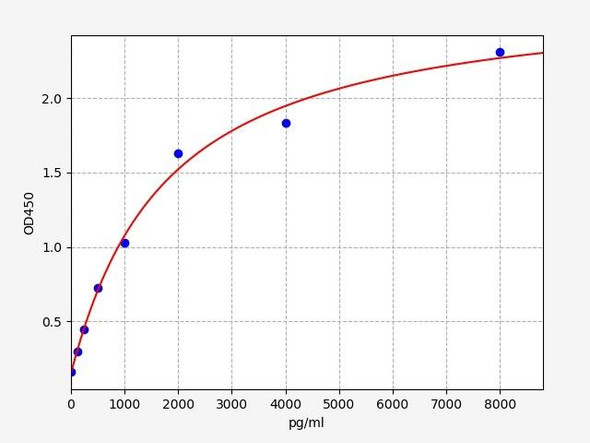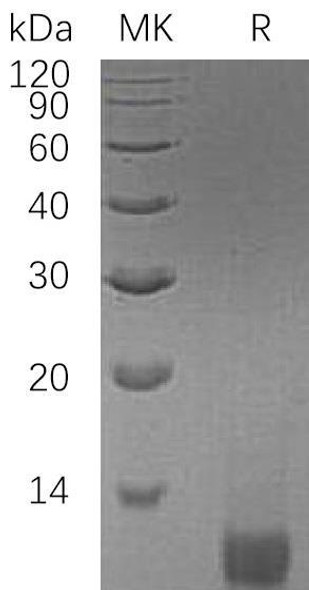Cytokines Recombinant Proteins
Human EMAP II Recombinant Protein (RPPB0175)
- SKU:
- RPPB0175
- Product Type:
- Recombinant Protein
- Species:
- Human
- Uniprot:
- Q12904
- Research Area:
- Cytokines
Description
| Product Name: | Human EMAP II Recombinant Protein |
| Product Code: | RPPB0175 |
| Size: | 20µg |
| Species: | Human |
| Target: | EMAP II |
| Synonyms: | AIMP1, EMAP2, EMAP-2, EMAPII, SCYE1, Multisynthetase complex auxiliary component p43, Endothelial monocyte-activating polypeptide 2, EMAP-II, p43. |
| Source: | Escherichia Coli |
| Physical Appearance: | Sterile Filtered White lyophilized (freeze-dried) powder. |
| Formulation: | Lyophilized from a concentrated (1mg/ml) solution in water containing 20mM sodium Phosphate buffer pH=7.5 and 130mM sodium chloride. |
| Solubility: | It is recommended to reconstitute the lyophilized EMAP-II in sterile 18M?-cm H2O not less than 100�g/ml, which can then be further diluted to other aqueous solutions. |
| Stability: | Lyophilized EMAP-II although stable at room temperature for 3 weeks, should be stored desiccated below -18°C. Upon reconstitution EMAP-II should be stored at 4°C between 2-7 days and for future use below -18°C.Please prevent freeze-thaw cycles. |
| Purity: | Greater than 98.0% as determined by(a) Analysis by RP-HPLC.(b) Analysis by SDS-PAGE. |
| Amino Acid Sequence: | SKPIDVSRLD LRIGCIITAR KHPDADSLYV EEVDVGEIAP RTVVSGLVNH VPLEQM QNRM VILLCNLKPA KMRGVLSQAM VMCASSPEKI EILAPPNGSV PGDRITFDAF PGEPDKELNP KKKIWEQIQP DLHTNDECVA TYKGVPFEVK GKGVCRAQTM SNSGIK |
| Biological Activity: | Determined by the apoptotic effect on MCF-7 cells using a concentration of 20-30 ng/ml. |
EMAP-II also called SCYE1 is a tumor derived cytokine that plays a role in a wide variety of activities on endothelial cells, monocytes and neutrophils. EMAP-II inhibits endothelial cell proliferation, vasculogenesis, neovessel formation, and can induce apoptosis. It is also chemotactic towards neutrophils and monocytes and induces myeloperoxidase activity from neutrophils. EMAP-II clinical value is inhibiting angiogenesis of vascular beds and suppressing the growth of primary and secondary tumors with no affect to normal tissues. SCYE1is specifically induced by apoptosis, and it is involved in the control of angiogenesis, inflammation, and wound healing. The release of this SCYE1 renders the tumor-associated vasculature sensitive to tumor necrosis factor. The precursor protein is identical to the p43 subunit, which is associated with the multi-tRNA synthetase complex, and it modulates aminoacylation activity of tRNA synthetase in normal cells. EMAP-2 plays a role in in the stimulation of inflammatory responses after proteolytic cleavage in tumor cells.
EMAP-II Recombinant Human produced in E.Coli is a single, non-glycosylated polypeptide chain containing 166 amino acids and having a molecular mass of 18.3 kDa. The EMAP-II is purified by proprietary chromatographic techniques.
| UniProt Protein Function: | Non-catalytic component of the multisynthase complex. Stimulates the catalytic activity of cytoplasmic arginyl-tRNA synthase. Binds tRNA. Possesses inflammatory cytokine activity. Negatively regulates TGF-beta signaling through stabilization of SMURF2 by binding to SMURF2 and inhibiting its SMAD7-mediated degradation. Involved in glucose homeostasis through induction of glucagon secretion at low glucose levels. Promotes dermal fibroblast proliferation and wound repair. Regulates KDELR1-mediated retention of HSP90B1/gp96 in the endoplasmic reticulum. Plays a role in angiogenesis by inducing endothelial cell migration at low concentrations and endothelian cell apoptosis at high concentrations. Induces maturation of dendritic cells and monocyte cell adhesion. Modulates endothelial cell responses by degrading HIF-1A through interaction with PSMA7. |
| NCBI Summary: | The protein encoded by this gene is a cytokine that is specifically induced by apoptosis, and it is involved in the control of angiogenesis, inflammation, and wound healing. The release of this cytokine renders the tumor-associated vasculature sensitive to tumor necrosis factor. The precursor protein is identical to the p43 subunit, which is associated with the multi-tRNA synthetase complex, and it modulates aminoacylation activity of tRNA synthetase in normal cells. This protein is also involved in the stimulation of inflammatory responses after proteolytic cleavage in tumor cells. Multiple transcript variants encoding different isoforms have been found for this gene. A pseudogene has been identified on chromosome 20. [provided by RefSeq, Dec 2008] |
| UniProt Code: | Q12904 |
| NCBI GenInfo Identifier: | 85700432 |
| NCBI Gene ID: | 9255 |
| NCBI Accession: | Q12904.2 |
| UniProt Secondary Accession: | Q12904,Q6FG28, Q96CQ9, B3KTR2, B4E1S7, |
| UniProt Related Accession: | Q12904 |
| Molecular Weight: | 37,039 Da |
| NCBI Full Name: | Aminoacyl tRNA synthase complex-interacting multifunctional protein 1 |
| NCBI Synonym Full Names: | aminoacyl tRNA synthetase complex interacting multifunctional protein 1 |
| NCBI Official Symbol: | AIMP1�� |
| NCBI Official Synonym Symbols: | p43; HLD3; EMAP2; SCYE1; EMAPII�� |
| NCBI Protein Information: | aminoacyl tRNA synthase complex-interacting multifunctional protein 1 |
| UniProt Protein Name: | Aminoacyl tRNA synthase complex-interacting multifunctional protein 1 |
| UniProt Synonym Protein Names: | Multisynthase complex auxiliary component p43 |
| Protein Family: | Aminoacyl tRNA synthase complex-interacting multifunctional protein |
| UniProt Gene Name: | AIMP1�� |
| UniProt Entry Name: | AIMP1_HUMAN |






